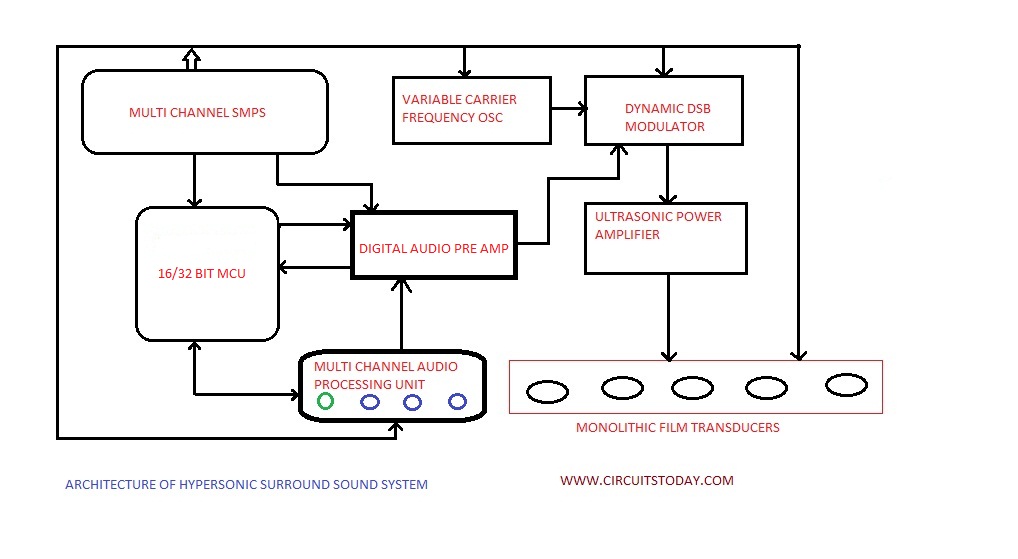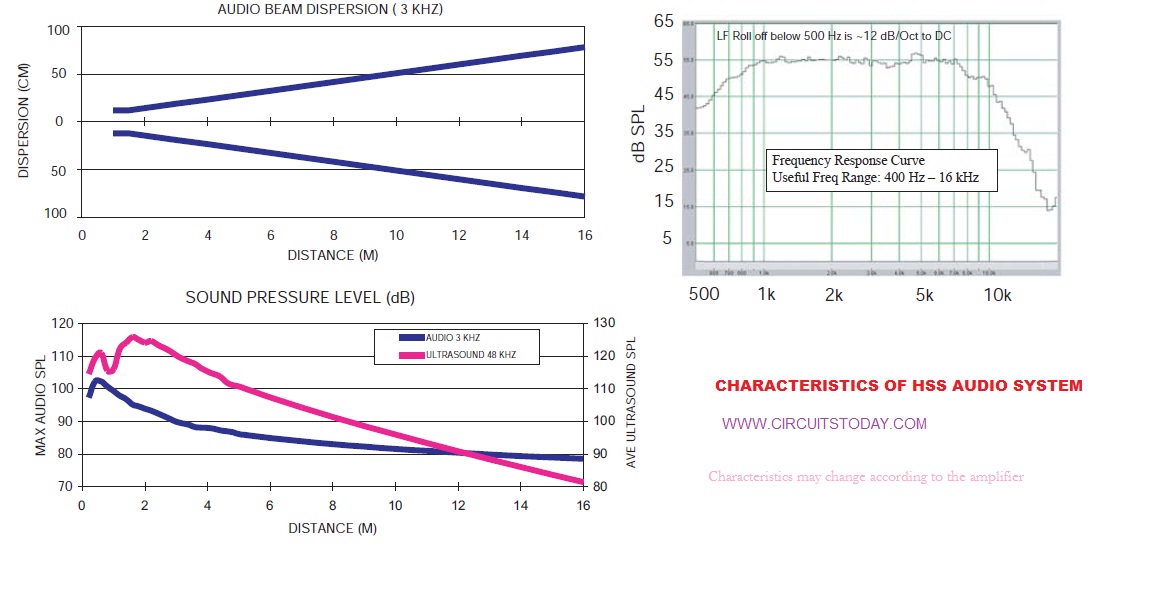
Hypersonic Sound (HSS) is one of the most revolutionary digital sound reproduction technologies of this century. It is considered one of the most innovative approaches to sound engineering. This technology was developed by American Technology Corporation. The biggest advantage of this technology is that it does not include any complex electronic circuits having enclosures, crossovers, woofers, and midrange or tweeter elements as compared to a conventional loudspeaker system. This technology also provides ideal characteristics to almost all audio frequencies (normal loudspeakers is not ideal for all frequencies such as 20Hz to 20 KHz).

The Hypersonic system produces highly directional audio without any disturbance for outside. By using this technology, we can create virtual real audio. This technology works with the help of modulated ultrasonic waves (above 40KHz) and these waves itself create audio frequency waves according to the input audio signal (This property of creating new audio waves within the ultrasonic wave is called non-linearity of air) .
For those who still don’t get what an HSS is; it’s kind of like this 🙂
Working of HSS System
HSS technology works on the property of non-linearity. Non-linearity is a property of air that creates new waves within another wave by the continuous expansion and contraction of waves. Here ultrasonic waves are used as modulated waves according to the input audio signal. This wave, when passing through the air, creates new sound waves within the range of human hearing (20Hz-20KHz). We can’t get any disturbance from the ultrasonic sound (since it can’t be heard by the human ear), we can only hear the newly generated audio waves (that same as the input audio).

The architecture of an ultrasonic transducer is given above. This structure consists of multiple sections as explained below
- SMPS
As like all electronic equipment, The HSS system is also powered with a highly filtered SMPS. Normally multi-voltage power supplies are used as SMPS. According to the power at the output, the supply voltage may vary from 12V to 60V.
- Microcontroller Unit
This unit can perform all the audio adjustments. Usually, 16 to 32-bit microcontrollers are used as the microcontroller.
- Audio Signal Processing Unit
Audio signal processing unit is an advanced audio circuit that consists of multichannel-Multi format High Definition Audio processor. This circuit detects and decodes all audio inputs and are filtered according to the requirement and sent to a digital pre-amp unit. We can provide several types of inputs to this unit like single channel, multichannel audio up to 11.2 channels, and also all the DTS and DOLBY digital true audio formats, etc. This section decodes almost all type of digital audios present. This unit also controls equalization, other dynamic controls, etc
- Digital Audio Pre-amp
Digital audio pre-amp is used for the pre-amplification of the decoded audio from the audio signal processor. After pre-amplification is completed, the pre-amplified audio is sent to the ultrasonic modulator
- Variable Carrier Frequency Oscillator (VCFO)
This is an ultrasonic oscillator circuit used for the generation of ultrasonic carrier waves for the modulation. Usually ultrasonic crystal oscillators are used for making these oscillations and its frequency is above 40 KHz.
- Dynamic DSB Modulator
Dynamic DSB modulator performs the Ultrasound modulation with the audio signal. In this unit, the input digital audio is modulated with the high-frequency ultrasonic waves and produces an HF modulated wave. This unit also filters all other HF disturbances too. In DSB system, the modulation index can be reduced to suppress all the distortions.
- Ultrasonic Power Amplifier
An ultrasonic power amplifier is an HF Power amplifier that increases the power at the output stage. This is the final stage of HSS amplifier unit. After the HF power amplification, the signal is fed to the monolithic film transducers, which transmit the HSS audio
- Monolithic Film Transducers
Monolithic Film Transducers are used for the emission of HSS waves into the air. Usually, piezoelectric polyvinylidene transducers are used as a transducer. The signal from the UF power amplifier is emitted into the air by a transducer. The ultrasonic waves are highly directional and transmit like a flashlight. Inside this range of HSS sound beam, the audio can be heard by a human. Outside this range, there is nothing to hear.
The characteristics and frequency response of HSS sound system is given below

Advantages
1) Highly focused directional audio
2) Very thin and lightweight transducer used as the ultrasonic emitter.
3) The sound only can hear within a particular angle.
4) Provide HD real audio for virtual reality (virtual real audio processing is possible).
5) Support multi-channel audio.
Disadvantages
1) High operating voltage required as compared to a normal audio amplifier.
2) Direct analog amplification is not possible.
3) Minimum stereo quality sound input required for the proper working.
4) High manufacturing cost.
Applications of Hypersonic Sound Systems
Hypersonic sound systems have a wide range of applications. The great advantage of such a directional sound system is that it is audible only to those in its focus; which means they won’t annoy any passersby. This has a massive scope in art, entertainment and hospitality industries. Imagine restricting the audio explanations of paintings in an art gallery only to those in front of that particular painting? Same goes for restaurants, retail, airports and, my favorite, video conferencing. These sound systems basically help to create a personal zone in a crowded place.
Other applications include military weapons. While most of them are still in R&D and restricted to Hollywood movies we may see some of them in the near future.

2 Comments
This site is one of the best sites I love him very